|
July, 2024
Human athleticism is on display at the 2024 Paris Games, but some Minnesota wildlife species would outperform even the greatest athletes.
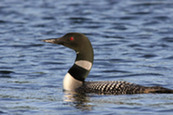
Diving: Common loon
The common loon can dive as deep as 250 feet, with no splash!
Unlike most birds, loons have solid bones. This extra weigh helps them dive when searching for food. They can even stay underwater for up to five minutes.
|
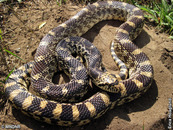
Wrestling: Bullsnake
Bullsnakes (also called gophersnakes) are long, strong and one of nature’s best wrestlers—taking down prey and even each other. They have many sets of vertebrae and ribs, allowing them to wrangle and maneuver around their prey. Their many muscles help them squeeze down.
During the mating season, male bullsnakes wrestle each other to prove their strength. The winner gets the gold, or in their case a chance to mate with a female bullsnake.
|
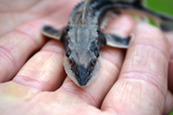
Marathon swimming: Lake sturgeon
Swimming over six miles is an admirable feat for a human, but that’s a breeze for the lake sturgeon. Tagged sturgeon have been tracked traveling over 300 miles.
Lake sturgeon live exclusively in freshwater. Historically, they were found in many lakes and rivers, but now they are a rare sighting and are primarily found in large rivers like the Mississippi and the St. Croix.
Photo by USFWS
|

Weightlifting: Ants
Humans train for years to lift three or four times their weight. For ants, that’s a light load. Ants can carry up to 10 times their body mass, using their strong neck and leg muscles to carry food back to their colonies.
Photo by USFWS
|
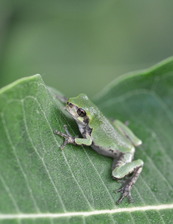
Long jump: Tree frog
The Olympic record for the long jump is 8.90 meters, or a little over 29 feet. Tree frogs can jump more than 5 feet, which seems less impressive on paper, but tree frogs are only 1 inch long. If we translate that to human terms, that would be like a person jumping more than 300 feet, roughly the height of the Statue of Liberty. Give this frog the gold!
Photo by USFWS
|
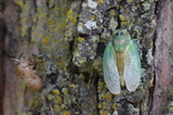
Step outside one summer evening and you will likely hear a chorus of insects. Crickets, katydids and cicadas hum and buzz all summer long in the hopes of finding a mate.
Check out Songs of Insects to identify what’s calling near you.
Photo by USFWS
|
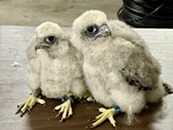
Peregrine banding
In June, Nongame Wildlife Program staff joined the Midwest Peregrine Society to band the chicks reared in the nest box shown on the DNR FalconCam. Both chicks were identified as males and received silver USFWS identification bands and field readable black and blue bands. Over the next few weeks, the chicks grew and then fledged on July 3 and July 4.
|

Wood turtle research
Wood turtles are a threatened species in Minnesota. Only about 5% of their nests are successful, due to predation and other factors. This summer, staff from the Minnesota DNR Nongame Wildlife Program are trying to increase wood turtle nest success.
We are removing encroaching vegetation and invasive species from nest sites and protecting wood turtle nests from predators using three methods: an electric fence around a nest area, a nest box that completely encloses a nest area, and an individual nest cage placed over a nest. So far, we have protected at least 47 wood turtle nests from predators using these methods.
Unfortunately, due to extreme flooding, about half of those nests were flooded. However, we learned a lot about how to find and protect nests, and we will monitor the nests that didn’t flood, to see if they hatch this fall.
|

Monitoring prairies
Staff in southern Minnesota are monitoring bumble bees and butterflies at restored prairie sites in Wildlife Management Areas and some state parks. We want to learn how effective those sites are for conserving these pollinators.
We are also looking into methods for testing whether adding more prairie violets (pictured) in targeted locations will help boost populations of regal fritillary butterflies, a prairie specialist that relies on prairie violets as the sole food source for their caterpillars. However, female regal fritillaries don’t lay their eggs on these violets, so their small caterpillars must find the violets on their own. By adding more prairie violets, we may be able to help those caterpillars mature into adult regal fritillaries, which helps to conserve this at-risk butterfly.
|
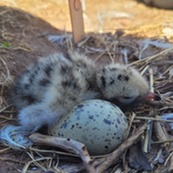
Common tern monitoring
The Nongame Wildlife Program is continuing its ongoing monitoring of common terns on Interstate Island in Duluth, with the help of dedicated volunteer Fred Strand. Common terns are a state threated species that are vulnerable to gulls taking over their nesting habitat and eating their eggs and chicks. Our annual survey keeps track of how many gulls are nesting on the island and the effectiveness of our common tern nest protections.
This summer, nest success has been quite high. Our nest protection efforts, in combination with an island restoration project (which added sand and gravel to the island to prevent erosion and flooding of the tern nesting area), really seem to be helping the terns.
|
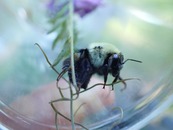
Minnesota Bumble Bee Atlas
Some of our staff volunteered for the Minnesota Bumble Bee Atlas, a statewide community science project aimed at tracking and conserving Minnesota's native bumble bees. We found several different species of bees during our survey at Spencer Brook WMA, including the brown-belted bumble bee (Bombus griseocollis) pictured.
|
For many Minnesotans, summer is a time of outdoor trips. Whether you’re camping, hiking or boating, we have some wildlife viewing tips to help keep you and wildlife safe:
🛥️ When recreating on one of our many lakes, keep an eye out for loons. Boats, boat motors and fishing line are very dangerous for Minnesota’s beloved state bird. Boaters, canoeists and kayakers should stay at least 100 feet from loons and their chicks while out on the water.
🐤If you come across a baby bird or young animal, please leave it be. In most cases, the parents are nearby and keeping watch over it. The adults may even be waiting for you to leave so they can feed their young. If you care, leave it there!
🧳 Pack some binoculars. This will help you get an up close, fascinating view of wildlife while maintaining a safe distance and without disturbing the animal. Always remember that wildlife is unpredictable, especially when stressed, so please enjoy watching them from afar.
|
Did you know that July has been World Prairie Month?
From burrowing owls to prairie skinks, Minnesota’s prairies are full of unique wildlife species. Learn all about them on our Prairie Wildlife webpage.
Photo is of a burrowing owl, taken by USFWS
|
|
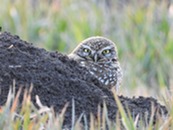 |
|